The Risks of Too Much Sun

1
/
17
The Risks of Catching Rays
It feels good to lounge in the sunshine, but it can hurt your health in the long run. Over the years, too much time outdoors can put you at risk for wrinkles, age spots, scaly patches called actinic keratosis, and skin cancer.
Swipe to advance
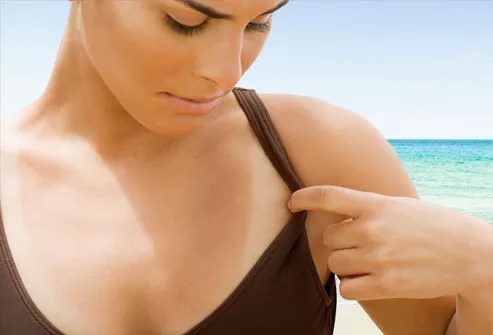
2
/
17
Suntan
A tan may look nice, but that golden color is due to an injury to the top layer of your skin.
When you soak up the sun's ultraviolet (UV) rays, it speeds up the aging of your skin and raises your risk of skin cancer. To prevent damage, use a "broad spectrum" sunscreen that is SPF 30 or higher.
Swipe to advance

3
/
17
Sunburn (First-Degree Burns)
There's no guesswork about whether you've got a sunburn. Your skin turns red, it feels hot to the touch, and you may have some mild pain.
It's called a first-degree burn when it affects only the outer layer of your skin. To get some relief from pain, take aspirin or ibuprofen. Try a cold compress, or apply some moisturizing cream or aloe.
Swipe to advance
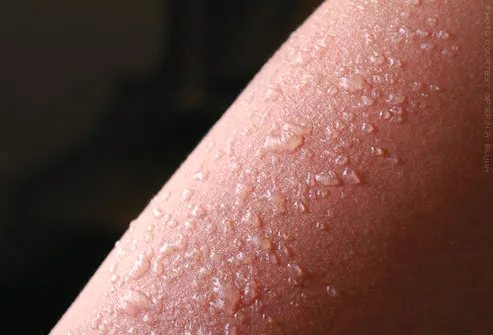
4
/
17
Sunburn (Second Degree)
A second-degree sunburn damages deep layers of your skin and nerve endings. It's usually more painful and takes longer to heal.
You may have redness and swelling. If blisters form, don't break them. They might get infected.
Swipe to advance
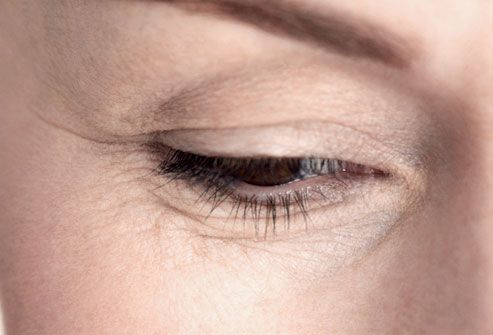
5
/
17
Wrinkles
The sun's rays can make you look old. Ultraviolet light in daylight damages the fibers in your skin called elastin and collagen. When that happens, it begins to sag and stretch.
Swipe to advance
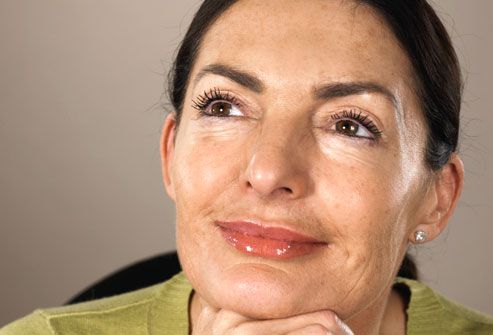
6
/
17
Uneven Skin Tone
Too much sun causes some areas of your skin to appear darker, while others look lighter. It can also make permanent changes in small blood vessels, which gives you a reddish look in places.
Swipe to advance
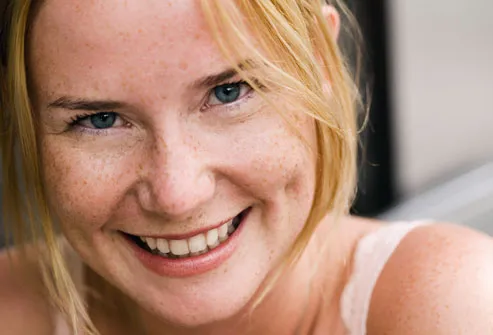
7
/
17
Freckles
You get these on areas of your body that are exposed to the sun. You'll notice them more in the summer, especially if you're fair-skinned or have light or red hair.
Freckles aren't bad for you. But some cancers in the earliest stages can look like one. See your doctor if the size, shape, or color of a spot changes, or if it itches or bleeds.
Swipe to advance
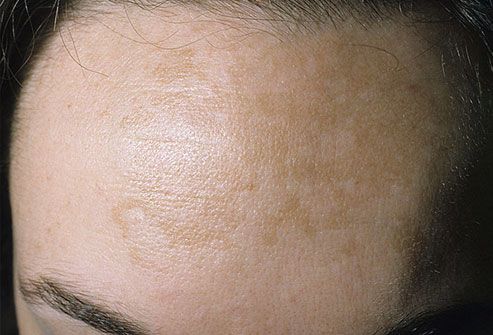
8
/
17
Melasma (Pregnancy Mask)
This shows up as tan or brown patches on your cheeks, nose, forehead, and chin. It's common among women who are pregnant, but men can get it too.
It may go away after your pregnancy ends, but you can also treat it with prescription creams and over-the-counter products.
Use sunscreen at all times if you have melasma, because daylight can make it worse.
Swipe to advance

9
/
17
Age Spots (Solar Lentigines)
These pesky brown or gray areas aren't really caused by aging, though more of them show up on your body as you get older. You get them from being out in the daylight. They often appear on your face, hands, and chest.
Bleaching creams, liquid nitrogen, Retin-A products, and topical benzoyl peroxide treatments can make them less obvious. They don't harm your health, but check with your doctor to make sure they're not something more serious, like skin cancer.
Swipe to advance
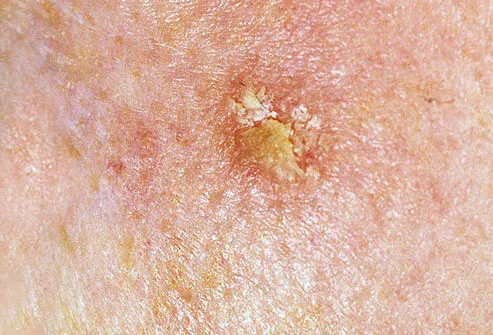
10
/
17
Actinic Keratosis (Solar Keratosis)
These red, brown, or skin-colored patches are small and scaly. You get them from being out in the daylight too much. They usually show up on your head, neck, or hands, but they can also appear on other parts of your body.
See your doctor, because if they're not treated they can sometimes turn into squamous cell carcinoma, a type of skin cancer.
Swipe to advance
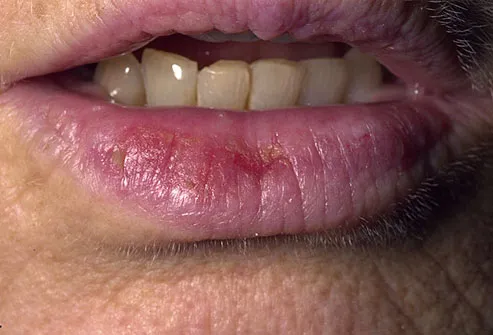
11
/
17
Actinic Cheilitis (Farmer’s Lip)
This usually appears on the lower lip, and you may have scaly patches, dryness and cracking, or swelling.
The sharp border-line between your lip and skin may also disappear.
Get this checked by your doctor. It may turn into squamous cell carcinoma if it's not treated.
Swipe to advance
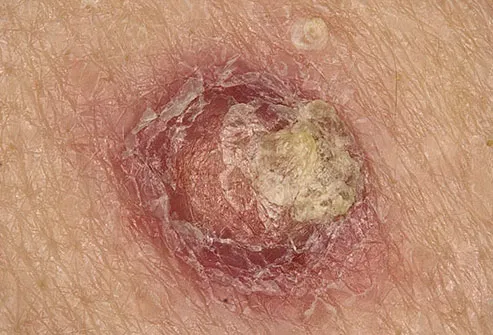
12
/
17
Squamous Cell Carcinoma
This type of skin cancer may show up as a firm red bump, a scaly growth that bleeds or gets a crust, or a sore that doesn't heal. It most often happens on your nose, forehead, ears, lower lip, hands, and other areas that get a lot of sun.
Squamous cell carcinoma can be cured if it's treated early.
Swipe to advance
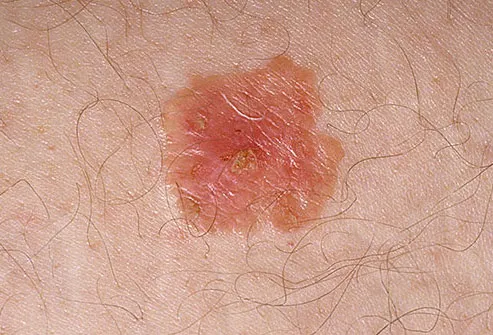
13
/
17
Bowen Disease
This is a type of skin cancer that's on the surface of your skin. Your doctor may also call it squamous cell carcinoma "in situ."
Unlike "invasive" squamous cell carcinoma, Bowen disease doesn't spread to the inside of your body. It looks like scaly, reddish patches that may be crusted.
Swipe to advance
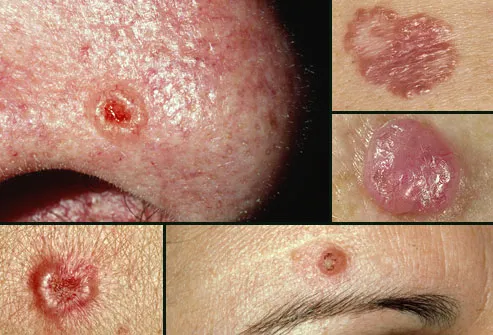
14
/
17
Basal Cell Carcinoma
This is the most common form of skin cancer, and it's the easiest to treat.
Basal cell carcinoma generally occurs on sun exposed skin and spreads slowly. The tumors can take on many forms, including a pearly white or waxy bump, often with visible blood vessels, on the ears, neck, or face.
A tumor can also appear as a flat, scaly, flesh-colored or brown patch or, more rarely, as a white, waxy scar on your back, chest, or legs.
Swipe to advance
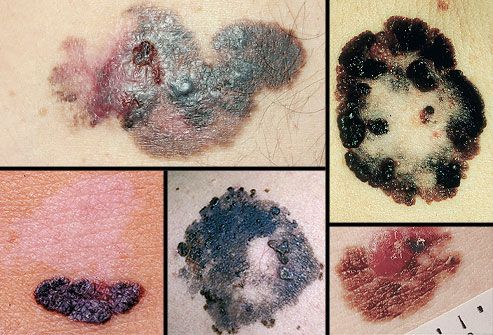
15
/
17
Melanoma
It's not as common as other types of skin cancer, but it's the most serious. Possible signs include a change in the way a mole or colored area looks.
Melanoma can affect the skin only, or it may spread to organs and bones. It can be cured if you get early treatment.
Swipe to advance
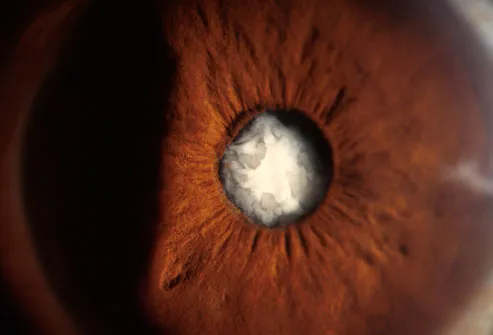
16
/
17
Cataract
This is a cloudy area in the lens of your eye. It's painless, but it may cause foggy vision, glare from light, and seeing double. You can help prevent cataracts by wearing a hat and sunglasses when you're in the sun.
Swipe to advance
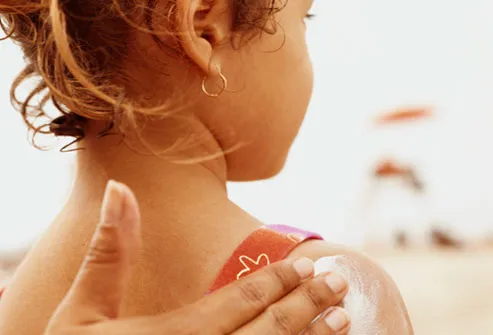
17
/
17
Shun the Sun
The best way to avoid sunburn, wrinkles, skin cancer, and other damage is to stay out of the daylight, especially between 10 a.m. and 2 p.m, when the sun's rays are strongest.
If you need to be outside, use a broad spectrum sunscreen with SPF 30, wear a UPF fabric hat and sunglasses, and cover up your skin with clothing.
If you see any changes to a mole or you spot a new growth or a sore that won't heal, see your doctor right way.
Swipe to advance
- Get link
- X
- Other Apps